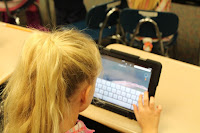Here is a list of a variety of different ways of documenting learning through text and images:
- Text can include using paper and pen, laptops and tablets. Various tools can also provide a backchannel such as Twitter, which from experience has proved a valuable way of reaching out to experts and audiences through the use of hashtags. Scheduled Twitter chat using hashtags are useful backchannel conversations for both students and teachers, and can be synchronous or asynchronous. Another popular backchannel tool is TodaysMeet which creates a more private URL for conversations. Google Docs can also be used for sharing and commenting
- Learning can also be documented through images and photographs, and combined with text using tools such as Skitch.
- Screenshooting is a valuable way of capturing an image that will change over time. Screencasting can also be a useful way of producing a video with audio narration (see next post).
- Sketchnoting is a visual representation of thoughts and idea and can be a useful way to communicate and document thinking. It provides visual evidence of thinking in terms of importance, relationships, hierarchy, sequences and so on. One tool I've used for this with students is Explain Everything.
- Comic Strips produce images in panels and rows with narrator captions and speech bubbles. An example of this I've used with students is Comic Life.
- Infographics are another great way of visually documenting learning, as they contain titles, shapes, icons, arrows and text to make thinking visible. Tools such as Piktochart, Canva and Easel.ly are simple to use by both students and teachers.
- Collages - these are a digital collection of images selected to convey a message. They can be made using tools such as PicCollage or images can be arranged freehand in slideshow tools.
And if all these are not enough .... the next blog post will be looking at ways of documenting learning using audio, video and blogging. See you soon!
Photo Credit: SchoolPRPro at Pixabay

No comments:
Post a Comment